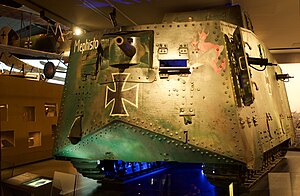| Sturmpanzerwagen A7V | |
|---|---|
 | |
| Type | Heavy tank |
| Place of origin | German Empire |
| Service history | |
| In service | 21 March 1918 – 16 October 1918 |
| Used by | German Empire |
| Wars | World War I German Revolution |
| Production history | |
| Designer | Joseph Vollmer |
| Designed | 1916 |
| Manufacturer | Daimler Motoren Gesellschaft |
| No. built | 20 |
| Specifications | |
| Mass | 31.5 t (31.0 long tons; 34.7 short tons) battle weight |
| Length | 7.34 m (24 ft 1 in) |
| Width | 3.1 m (10 ft 2 in) |
| Height | 3.3 m (10 ft 10 in) |
| Crew | A minimum of 18, sometimes up to 25. |
| Armor | 5 to 30 mm (0.20 to 1.18 in)[1] |
Main armament | 5.7 cm Maxim-Nordenfelt (initially with 180 rounds; later 300) |
Secondary armament | 6 × 7.9 mm machine guns 36,000 rounds |
| Engine | 2 × Daimler-Benz 4-cylinder 200 hp (149 kW) total |
| Power/weight | 6.5 hp/tonne |
| Transmission | Adler gearboxes and differentials |
| Suspension | Holt track, vertical springs |
Operational range | 30–80 km (19–50 mi) |
| Maximum speed | 15 km/h (9.3 mph) on roads 6.4 km/h (4.0 mph) cross-country |
The Sturmpanzerwagen A7V was a heavy tank introduced by Germany in 1918 during World War I. One hundred chassis were ordered in early 1917, ten to be finished as fighting vehicles with armoured bodies, and the remainder as Überlandwagen cargo carriers.[2] The number to be armoured was later increased to 20. They were used in action from March to October 1918, and were the only tanks produced by Germany in World War I to be used in combat, as well as being the first operational German Tank.[3] It was developed as a response to British tanks. Although the A7V is generally considered to be better designed compared to its counterparts, it struggled to procure high production numbers due to its relative complexity and high cost.[4][5][6]
- ^ Hull front: 30 mm (1.2 in), hull rear & sides: 15 mm (0.59 in), hull top:6 mm (0.24 in) Funk (2003), p. 135, command cupola: 20 mm (0.79 in) front, 15 mm (0.59 in) rear & sides and 5 mm (0.20 in) on top Funk (2003), p. 135
- ^ Zaloga (2006), pp. 7–10.
- ^ Tucker (2004), pp. 24–25.
- ^ "The A7V Sturm Panzerkraftwagen". www.keymilitary.com. 16 April 2020. Retrieved 14 December 2023.
- ^ Nye, Logan (29 April 2020). "Autopsy of a German tank killed in World War I combat". We Are The Mighty. Retrieved 14 December 2023.
- ^ Larson, Caleb (5 September 2021). "Meet the German Empire's WWI Herculean Heavy tank". The National Interest. Retrieved 14 December 2023.